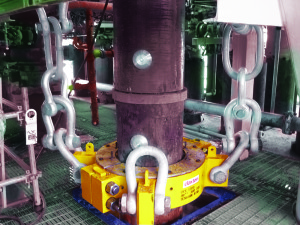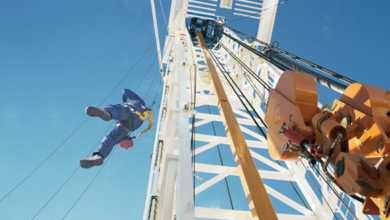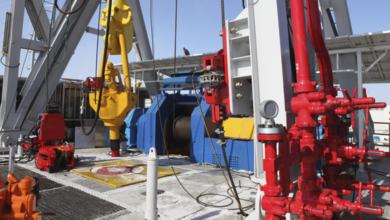D&C Tech Digest
Data pods provide BOP, lower riser info for integrity verification

Fugro has delivered a motion data set from the BOP stack and lower riser of two deepwater wells in the Barents Sea using its DeepData pods. The pods are the core of a data-acquisition system designed to operate in depths up to 2,400 m. The pods use high-precision accelerometers and angular rate sensors to determine motions and rotation at specified locations. DeepData also accepts inputs from external sensors, such as strain gauges.
To verify the integrity of its subsea assets during a drilling campaign in the Barents Sea, the operator recorded motion and strain of the wellhead, BOP and riser for two wells to quantify fatigue damage incurred by the wellhead.
Operating in water depths up to 1,400 m, the modular logging system collected and analyzed data from a range of sensors at critical wellhead locations. An ROV was used for interim data recovery and battery replacement.
The DeepData pods achieved a 100% data recording success rate during the deployment of nearly one year. The resulting data sets will enable the operator to build a history of wellhead fatigue and recalibrate the fatigue model of the riser. This information will enable detailed analysis of vortex-induced vibrations and wellhead fatigue so that the remaining fatigue life of the assets can be estimated.
Fugro also has developed and delivered a fully integrated helideck monitoring system to Diamond Offshore’s Ocean Guardian in the North Sea. Severe weather conditions in the North Sea can cause major disruptions to offshore operations, so Diamond Offshore and its client wanted to better understand the direct correlation between the wind, waves and the performance of the rig anchoring system, as well as accurate stationkeeping, particularly during storm events.
The Ocean Guardian’s enhanced monitoring now includes helideck monitoring of weather, cloud, visibility and helideck motion, as well as wave and air gap data for ballasting operations.

First Dopeless technology well drilled on North Slope
A European oil and gas company has drilled the first Dopeless technology well on Alaska’s North Slope, on the northern part of the Brooks Range on the coast of the Arctic Ocean. The operator was able to save approximately 6.1 hours of rig time and 84 manhours, according to Tenaris. The TenarisHydril Wedge 521 and Wedge 563 premium connections with Dopeless technology were used on an L80 steel grade. There were zero rejects and zero re-makeups after running 750 joints with Dopeless technology.
Colorado pilot wells prove proppant application system
Preferred Technology, an affiliate of Preferred Sands, recently completed a series of DustPRO proppant pilot wells in Colorado. Third-party industrial hygiene results came back below existing and proposed OSHA silica permissible exposure limits regarding crystalline silica.
Launched through a partnership between Preferred and The Dow Chemical Co, the DustPRO proppant application system helps to control respirable silica and fugitive dust during all sand transfer points. The proppant is based on Dow’s patent-pending Preferred DC technology, which is highly compatible with frac fluids and does not alter proppant characteristics.
In addition to all personnel samples falling below current and proposed silica exposure limits, a significant increase in on-site efficiency was reported. Applied at the sand origin site or terminal, the system eliminates costly and time-consuming mechanical silica dust solutions and allows employees to safely access critical equipment.
Real-time wellhead fatigue monitoring prevents damage
Pulse Structural Monitoring has provided a real-time wellhead fatigue monitoring system for Hurricane Energy on the Lancaster Discovery, west of Shetland in the UK North Sea. The operator wanted to check the wellhead fatigue model during drilling operations to prevent significant damage. Real-time monitoring provided early warning of excessive movement and instant visualization of any wellhead fatigue damage from the rig.
The well was drilled horizontally through fractured granite basement to obtain commercial flow and protect the Lancaster asset.

TIW delivers safety valves for MWCC system
TIW Corp has delivered two large-diameter Ball Type Safety Valves to Marine Well Containment Co (MWCC) for use with its expanded containment system. The class II Ball-Type Hurricane Valves will become a component of MWCC’s containment system for the capture of fluids from an uncontained subsea well in water depths up to 10,000 ft. In a hurricane or other event requiring vessels to leave the wellsite, the valve will add to the vessel’s ability to isolate flow, safely disconnect, depart the site and later return and reconnect.
Modular offshore rig design reduces deployment costs
William Jacob Management has introduced the 3,000-hp Modular Offshore Rig Facility. The rig has two main modules: the drilling equipment set (DES) and the drilling support module (DSM).
The DES has the capacity to access 15 wells arranged in a 3 x 5 matrix and is capable of drilling wells up to 25,000 ft. The DSM is equipped with a pair of rig cranes that streamline installation. The blocks containing the cranes are installed using a temporary leapfrog crane package. Once the rig cranes are operational, the installation is then completed using the rig’s own cranes. This strategy effectively eliminates the need to contract a lift barge.
Stuck BHA removed using slot recovery method

Claxton Engineering Services, an Acteon company, has completed the first rigless removal of a stuck bottomhole assembly (BHA). The work was completed during a slot recovery operation at Maersk Oil’s Tyra East field in the Danish sector of the North Sea. The well was drilled in the 1980s and, during construction, the BHA had become stuck in the conductor pipe and prevented well completion. Claxton used its slot recovery methodology and tooling, specialist cutting equipment and a dive support vessel to solve the issue.
The program began with the deployment of a specialist casing-cutting system to remove a section of the conductor, which left the stuck BHA intact but exposed. This called for modification of the cutting equipment and the subsea application of a system that is normally used on the surface.
Claxton engineers prepared a specialized lifting device using an air hoist on deck deployed through an A-frame, while divers clamped the lifting gear to the BHA. The BHA was too heavy to recover in one piece and had to be cut subsea. Once the cutting machine had sliced through the conductor and the BHA, the top section was recovered.
During planning, the orientation of the remaining BHA relative to the conductor stump was uncertain. Claxton created a whipstock with a slot beneath the landing plate that would enable it to capture the exposed part of the BHA securely in any orientation. The top half of the whipstock would rotate on this base and enable the new well to be kicked off in any direction.
The team completed the operation in less than 16 days, including more than three days waiting on weather.
SDI completes 500th MagTraC MWD ranging
Scientific Drilling International (SDI) has completed the 500th MagTraC MWD Ranging project. MagTraC was introduced in 1998 to target challenging applications where uncertainty and risk play a major factor in well construction. The system uses raw MWD data to calculate the relative position between wellbores.
The 500th project required SDI to drill two boreholes with only 3 m of spacing in Saskatchewan, Canada, with the intent of running electrical cables from surface to underground mine shafts. Using SDI’s MWD and Keeper Wireline gyro, as well as ranging on the second well at five different intervals, anti-collision requirements were met.
Well intervention completed in 6,700 ft without riser
Blue Ocean Technologies has set multiple records in subsea well intervention by intervening in, and subsequently plugging and abandoning, a production gas well in 6,700 ft (2,042 m) of water and approximately 12,600 ft (3,840 m) downhole without a riser, according to the company. The intervention took place in Atwater Valley Block 426, approximately 240 km south-southeast of Port Fourchon, La., in the Gulf of Mexico.
Blue Ocean Technologies completed the well with its Interchangeable Riserless Intervention System, using a dynamically positioned vessel as the work platform. This project marks the first time that wireline has successfully run in open water at 6,700 ft.
Click here for more articles about industry technology milestones and downhole or subsea innovations are available on DC’s Innovating While Drilling microsite.



